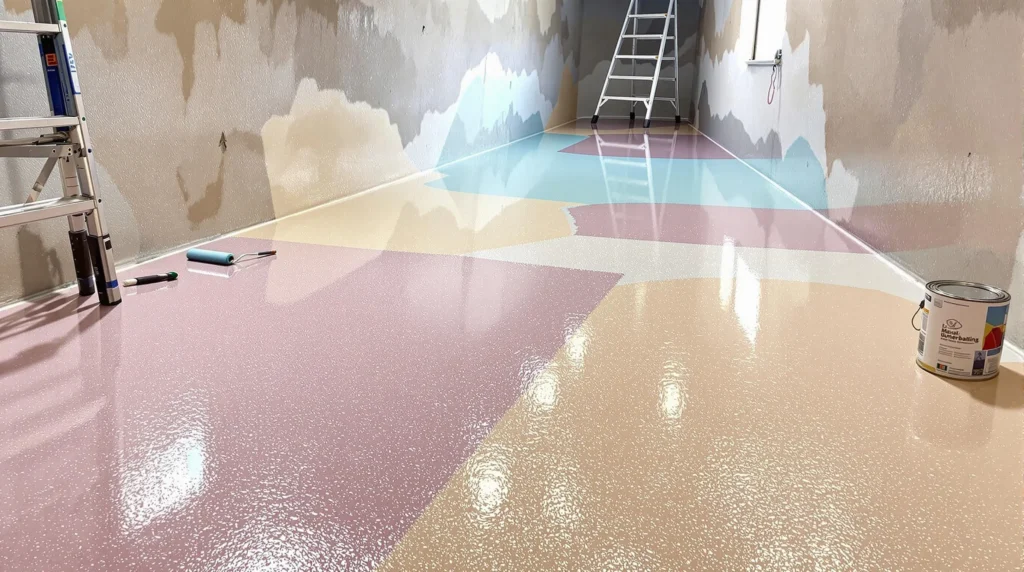Transforming your basement floor with the right paint can dramatically improve both its appearance and durability. We’ve researched and tested many options to help you find the perfect solution for your space. Whether you’re looking to brighten a dark basement, create a moisture-resistant barrier, or simply refresh an outdated concrete floor, choosing the right paint is crucial.
Our comprehensive guide will walk you through the best paint options for basement floors, taking into consideration factors like moisture resistance, durability, and ease of application. We’ll compare epoxy coatings, latex floor paints, and specialized concrete sealers to help you make an well-informed choice. With our expert recommendations, you’ll be able to select a product that not only looks great but also stands up to the unique challenges basement environments present.
Why Painting Your Basement Floor Is a Smart Investment
Investing in quality basement floor paint delivers remarkable returns beyond mere aesthetics. Many homeowners overlook their basement’s potential until they discover how a fresh coat of specialized floor paint can transform the space. Basement painting projects typically cost between $0.50 to $5 per square foot depending on the product chosen, yet they can increase your home’s value by up to 15%.
Financial benefits extend well beyond the initial investment through reduced maintenance costs and longer floor lifespans. Properly painted basement floors create moisture barriers that prevent dampness from seeping upward, protecting your entire home from potential water damage and mold issues. Concrete floors without protective coatings absorb stains, moisture, and can gradually deteriorate, while painted surfaces resist these common basement problems.
Temperature regulation improves significantly with certain reflective floor paints, potentially reducing heating costs during colder months. Families with allergies benefit tremendously from painted basement floors as they eliminate dust-trapping porous surfaces where allergens frequently accumulate. Visually, a well-painted floor can make your basement appear larger, brighter, and more inviting for various activities.
Maintenance becomes remarkably simpler once a quality basement floor paint is applied correctly. Most premium floor coatings only require occasional sweeping and light mopping rather than intensive scrubbing or specialized cleaning products. Property valuation experts consistently rank finished basements among the top renovation projects for return on investment, with floor improvements playing a crucial role in overall basement appeal.
10 Best Paints for Basement Floors in 2024
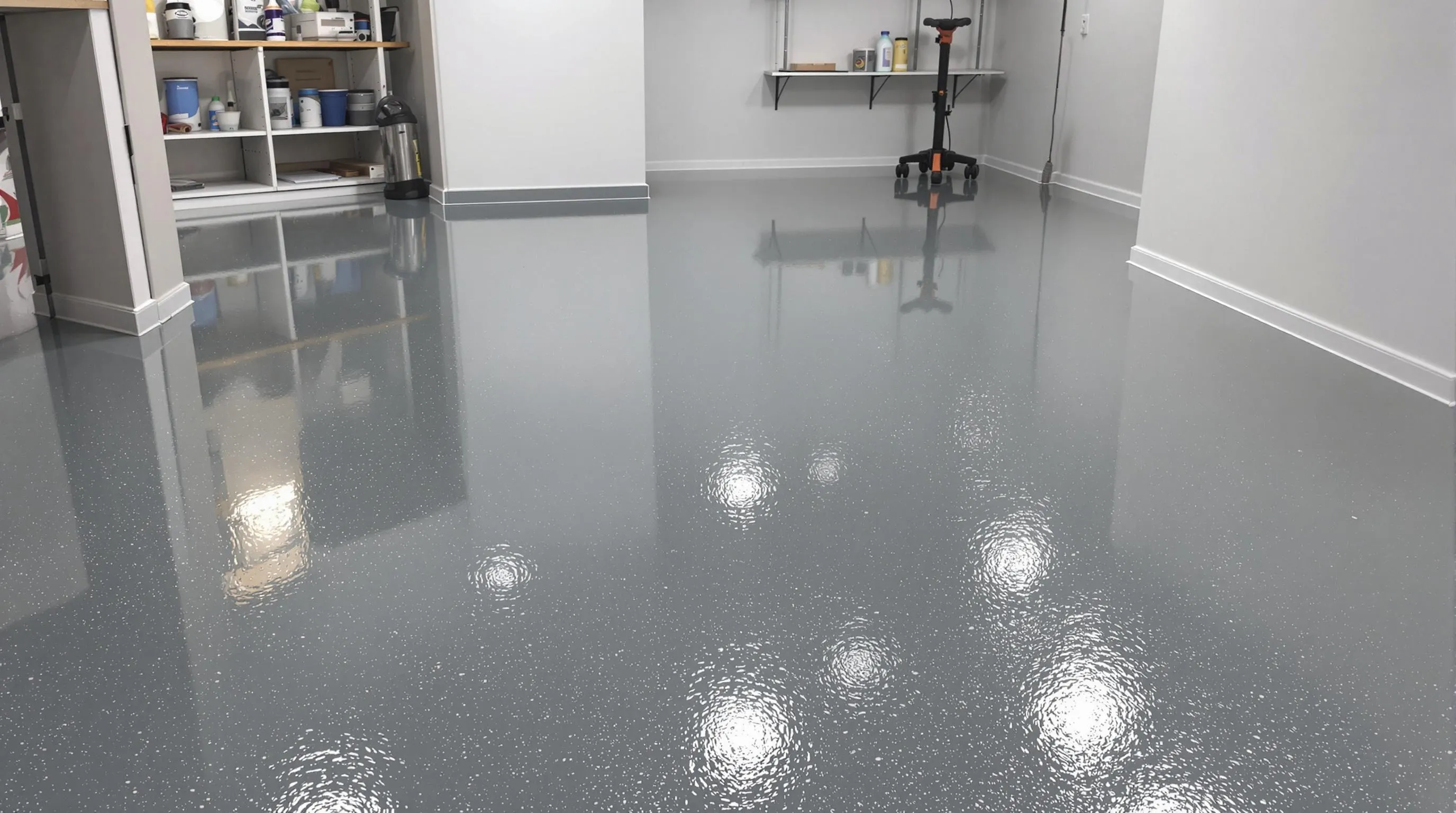
Choosing the right paint for your basement floor can transform the space while providing essential protection against moisture and wear. Here are our top recommendations for basement floor paints in 2024.
Epoxy-Based Floor Paints
Epoxy floor paints stand out as the most durable option for high-traffic basement areas. These paints create a glossy, seamless finish that bonds exceptionally well to concrete surfaces. Their chemical resistance makes them perfect for workshops or utility areas where spills might occur. Proper surface preparation is crucial for epoxy application, requiring thorough cleaning and etching of the concrete to ensure maximum adhesion. Many homeowners choose epoxy for its long-lasting protection that can withstand heavy furniture, foot traffic, and potential moisture issues.
Latex Acrylic Floor Paints
Latex acrylic paints offer excellent options for basements with less intense usage patterns. Products like Kilz Interior/Exterior Masonry Paint provide reliable mold and mildew resistance with low VOC emissions, making them environmentally friendly choices. For added safety in potentially damp basement environments, INSL-X Sure Step Acrylic Anti-Slip Paint delivers superior slip resistance while maintaining good moisture protection. These water-based formulations dry quickly and produce minimal odors during application, though they don’t match the durability of epoxy systems for heavy-use areas.
Polyurethane Floor Coatings
Polyurethane coatings deliver exceptional flexibility and abrasion resistance for basement floors. Their UV-resistant properties prevent yellowing over time, maintaining the floor’s appearance for years. Professional installers often apply polyurethane as a protective topcoat over epoxy systems to create a hybrid solution with maximum durability and aesthetic appeal. These coatings create a tough protective layer that resists scratches from furniture movement and daily wear while maintaining their clarity and shine longer than other options.
Concrete Stains and Sealers
Concrete stains penetrate the surface to enhance the natural texture and character of your basement floor. These products allow the concrete’s unique patterns to show through while adding color and visual interest. Sealers work alongside stains to lock in color and provide essential water resistance. Budget-conscious homeowners often select acrylic sealers for their affordability and ease of application. For superior protection in potentially damp basements, epoxy sealers offer enhanced durability and moisture resistance, though at a higher price point and with more complex application requirements.
Water-Based vs. Oil-Based Options
Water-based floor paints feature low odor emissions and quick drying times, making them ideal for occupied homes. Latex acrylics fall into this category, offering good coverage with minimal environmental impact, though they typically don’t provide the same level of durability as other options. Oil-based alternatives deliver superior moisture resistance and durability in basement environments, creating a harder, more protective finish. These products require longer curing times and produce stronger fumes during application, necessitating proper ventilation throughout the painting process. Your choice between these options should balance indoor air quality concerns with the desired level of floor protection.
Polyurea/Polyaspartic Coatings
Polyurea and polyaspartic coatings represent the cutting edge in basement floor protection with four times the strength of standard epoxy. Professional contractors typically apply these rapid-curing, completely waterproof systems that resist cracking even with temperature fluctuations. Their chemical resistance makes them suitable for workshop areas, while their exceptional durability handles heavy furniture and high traffic. Though more expensive than DIY options, these professional-grade coatings provide the ultimate long-term solution for basement floors.
Anti-Slip Additive Paints
Anti-slip paints incorporate special grit particles to enhance traction on basement floors. Products like INSL-X Sure Step are specifically formulated to create safer surfaces in potentially wet or slippery conditions. These specialized coatings prove particularly valuable near basement exits, laundry areas, or spaces where moisture might accumulate. Their textured finish provides peace of mind without sacrificing appearance, making them smart choices for family homes with children or elderly residents.
Masonry Paints (Non-Floor Exact)
Masonry paints like Kilz Interior/Exterior provide good coverage for vertical concrete surfaces in basements. These products adhere well to walls and columns but lack the durability needed for floor applications. Their formulations focus on coverage rather than wear resistance, making them inappropriate for areas with foot traffic. Homeowners should avoid using general masonry paints on floors even though their lower cost, as they’ll deteriorate quickly under normal use conditions.
Two-Part Epoxy Kits
Two-part epoxy kits combine resin and hardener components to create exceptionally strong bonds with concrete substrates. DIY-friendly options provide homeowners with professional-quality results when properly mixed and applied. These systems offer excellent protection against moisture penetration common in below-grade spaces. Careful attention to mixing ratios and application temperatures ensures maximum adhesion and performance, making them popular choices for garage and basement renovations.
Moisture-Cured Urethanes
Moisture-cured urethane coatings harness basement humidity to create their chemical bond. These high-performance products are specifically engineered for challenging environments with persistent dampness. Their advanced chemistry provides excellent protection while being compatible with less-than-ideal moisture conditions. Application requires careful attention to manufacturer guidelines, often making them better suited for professional installation. Their specialized properties make them worth considering for basements with known moisture issues that can’t be fully remediated.
Key Factors to Consider When Choosing Basement Floor Paint

Selecting the right paint for your basement floor requires careful consideration of several critical factors that will impact both performance and longevity. Here’s what you need to evaluate before making your decision:
Moisture Resistance Capabilities
Moisture resistance stands as the most crucial factor when selecting basement floor paint. Basements naturally tend to be damp environments that can compromise standard paints. Products specifically formulated with waterproofing properties like Zinsser WaterTite LX create an impermeable barrier against water infiltration. This specialized paint prevents moisture from seeping through concrete, effectively blocking potential water damage. Proper moisture-resistant paint also combats mildew and mold growth, which commonly plague basement spaces.
Durability and Traffic Tolerance
Basement floors must withstand consistent foot traffic and occasional heavy loads. DRYLOK Latex Concrete Floor Paint offers exceptional durability designed specifically for masonry floors. Quality floor paints resist scuffing, scratching, and fading even under regular use. The best options provide a hard-wearing surface that maintains its appearance for years without requiring frequent touch-ups. Paints with reinforced formulas can even handle occasional furniture movement and moderate impacts without showing wear.
Application Process Requirements
Application complexity varies significantly between basement floor paint products. DRYLOK Latex Concrete Floor Paint simplifies the process with its all-in-one primer and paint formula. Some products require multiple preparatory steps including thorough cleaning, etching, and priming before application. Coverage rates typically range from 250-400 square feet per gallon depending on concrete porosity. Products with self-leveling properties make application more forgiving for DIY enthusiasts without specialized equipment.
Drying and Curing Time
Drying and curing times directly impact how quickly you can use your basement after painting. Most basement floor paints become touch-dry within 4-6 hours, but complete curing takes significantly longer. Environmental factors like humidity and temperature dramatically affect these timeframes. Some quick-drying formulations allow light foot traffic within 24 hours, while full curing for maximum durability typically requires 5-7 days. Planning around these timeframes helps ensure optimal results and prevents premature damage to your newly painted surface.
VOC Content and Safety
VOC (volatile organic compound) levels affect indoor air quality and should be minimized in basement applications. Zinsser WaterTite LX features low odor formulation with reduced VOCs, making it safer for indoor use. Low-VOC and zero-VOC options have become increasingly available, providing environmentally responsible alternatives that reduce harmful emissions. Proper ventilation remains essential during application regardless of VOC content. Water-based formulations typically offer important safety advantages over solvent-based alternatives while maintaining excellent performance characteristics for basement environments.
Step-by-Step Guide to Painting Your Basement Floor
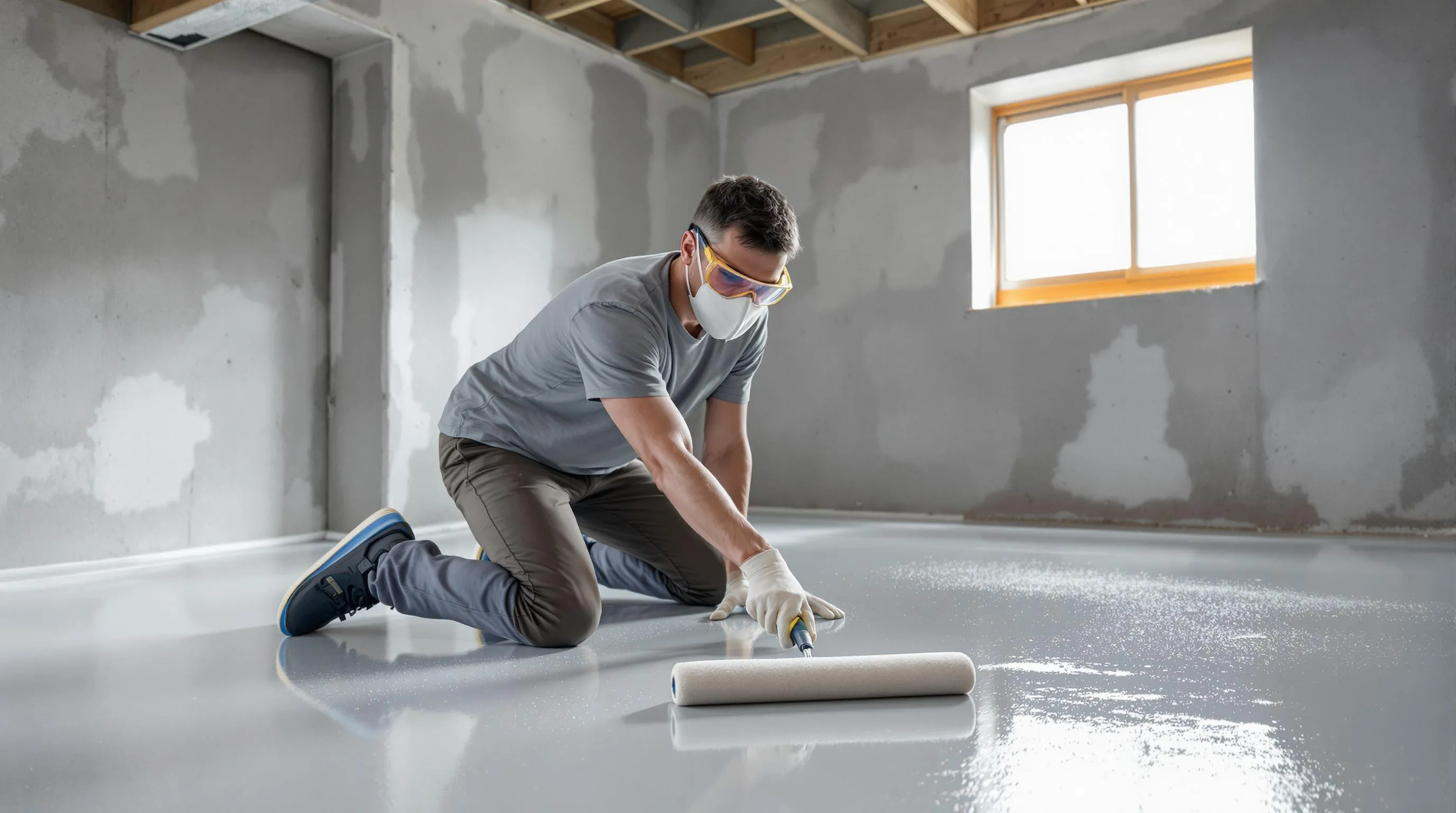
Transforming your basement floor with paint requires careful planning and execution to achieve lasting results. Follow our comprehensive guide to ensure your basement floor painting project succeeds.
Proper Surface Preparation
Successful basement floor painting begins with thorough surface preparation. Start by cleaning the entire floor surface, removing all grease, dust, and debris that could interfere with paint adhesion. Repair any cracks in the concrete using a quality concrete filler product before proceeding with the painting process. Etching the concrete is essential—either use an acid etcher or a mechanical grinder to create the perfect profile for paint adhesion. Most importantly, ensure your basement floor is completely dry before applying any paint, as moisture trapped beneath paint will lead to failure. Remember that skipping proper preparation is the leading cause of floor paint peeling and early deterioration.
Application Techniques for Professional Results
Different paint types require exact application methods for optimal results. For epoxy paints—the most durable option—mix the resin and hardener thoroughly and apply within the recommended 1-2 hour working time using a roller with a ½-inch nap. Latex and acrylic paints perform best when applied using an angled brush for edges and corners, followed by a roller for larger areas. Apply thin, even coats rather than thick layers to prevent bubbling and ensure proper curing. Allow sufficient drying time between coats—typically 24-72 hours depending on the product and environmental conditions. Using proper ventilation during application protects your health and promotes faster drying times. Products like DRYLOK Latex Concrete Floor Paint offer user-friendly application in just one step with 16 color options.
Common Mistakes to Avoid
Many DIYers underestimate the importance of environmental conditions when painting basement floors. Applying paint in high humidity or cold temperatures will compromise adhesion and extend drying times significantly. Overloading your roller with too much paint creates an uneven texture and can lead to bubbling as the paint dries. Walking on the floor before it’s fully cured—which takes approximately seven days for epoxy products—can damage the finish permanently. Using standard masonry paint like Kilz Interior/Exterior products for floors is another common error, as these aren’t designed to withstand foot traffic. For safety concerns, consider incorporating anti-slip additives into your paint, especially in potentially wet areas. Benjamin Moore INSL-X Sure Step Acrylic paint comes with built-in anti-slip texture that’s particularly valuable for basement applications.
Budget-Friendly vs. Premium Basement Floor Paint Options
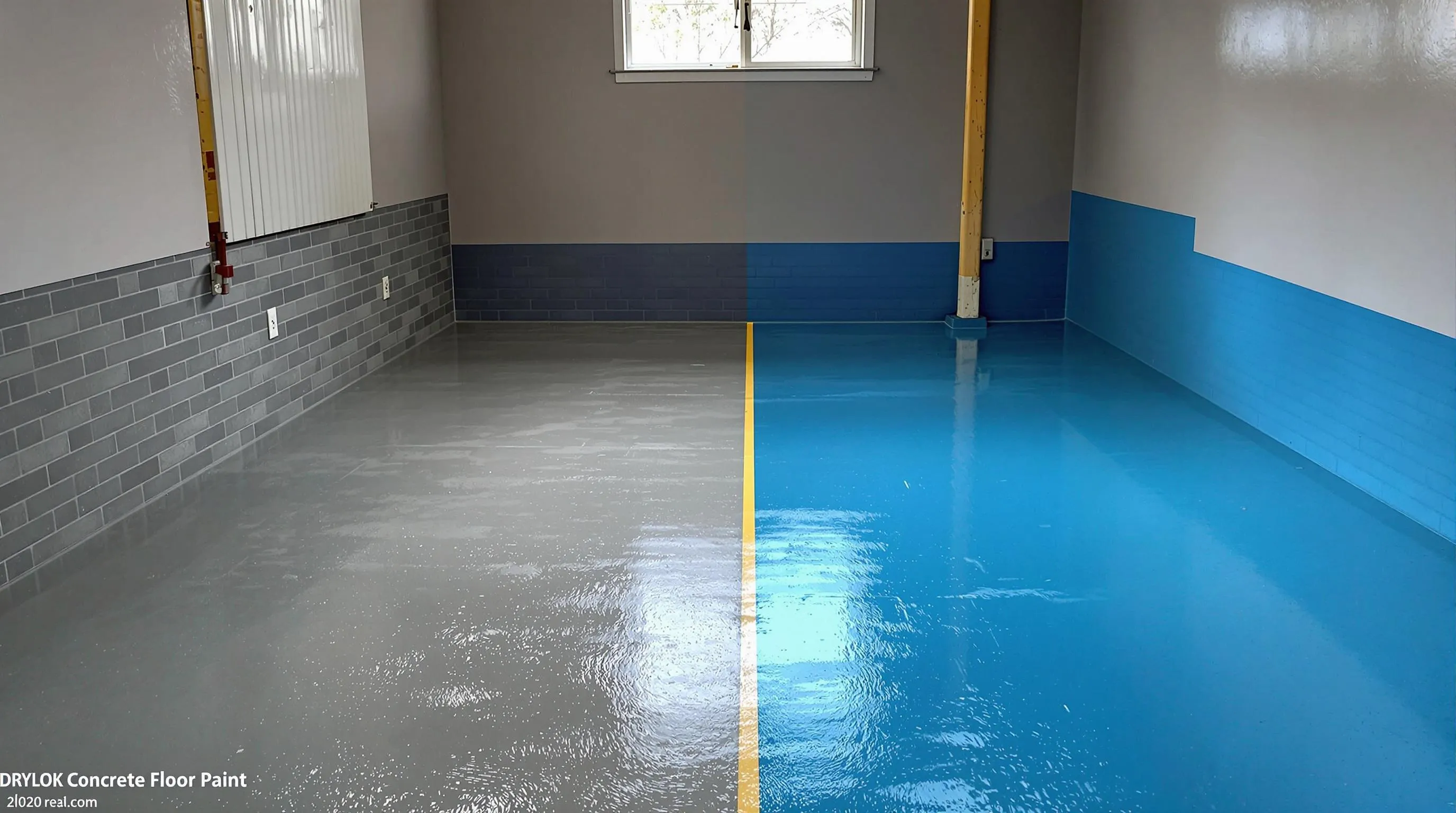
Budget-Friendly Paints
KILZ Interior/Exterior Masonry Paint offers an affordable solution for homeowners looking to improve their basement floors without very costly. This acrylic-based formula resists mold and mildew growth, making it suitable for both vertical and horizontal basement surfaces, though it’s not ideal for high-traffic floor areas. With coverage of 250-400 square feet and a flat finish, it particularly excels in damp basement environments where moisture control is essential.
Standard acrylic coatings represent the most cost-effective option in the basement floor paint market. These budget-friendly formulations provide basic moisture protection that can help preserve your concrete surfaces. Their main limitation appears in their reduced durability compared to more premium alternatives, potentially requiring more frequent reapplication in areas that see regular use.
Premium Paints
DRYLOK Latex Concrete Floor Paint stands out as a premium one-step paint and primer combination that eliminates the need for multiple products. Its non-slip finish enhances safety in basement environments, while the impressive selection of 16 color options allows for greater design flexibility. Specifically engineered for masonry floors, this paint cleans easily with just soap and water, making maintenance virtually effortless for homeowners.
Benjamin Moore INSL-X Tough Shield delivers professional-grade performance with its water-based acrylic formulation suitable for both concrete and wood surfaces. Coverage ranges from 350-450 square feet per gallon, providing excellent value even though its premium price point. Testing under extreme conditions proves this paint’s versatility for both interior and exterior applications, making it an investment-grade choice for serious basement renovations.
Benjamin Moore INSL-X Sure Step combines anti-slip protection with superior moisture resistance in one premium package. This advanced acrylic paint specifically addresses the unique challenges of basement floors requiring exceptional durability. Its specialized formula creates a protective barrier that stands up to the demanding conditions typically found in below-grade spaces.
Key Comparisons
Durability differences between budget and premium options become apparent over time, with standard acrylics typically requiring more frequent maintenance and reapplication. Mid-range epoxy options balance cost considerations with longer service life, while premium acrylics like the INSL-X line deliver industrial-grade resilience that can withstand years of regular use without important deterioration.
Cost versus performance analysis shows budget paints like KILZ work well for low-traffic or occasionally used basement areas where premium protection isn’t necessary. High-use basement floors benefit substantially from the investment in premium options such as DRYLOK or INSL-X, which provide superior long-term protection against moisture, wear, and staining.
Application requirements vary significantly between price points, with budget-friendly paints like KILZ typically requiring two or more coats for adequate coverage. Premium one-step formulations like DRYLOK simplify the painting process considerably, often achieving full coverage and protection with just a single application, saving both time and effort for DIY enthusiasts.
Proper surface preparation remains essential regardless of which paint option you choose. All concrete floors should be thoroughly cleaned, etched when necessary, and tested for moisture issues before application begins. Testing for moisture problems is particularly important when selecting between budget and premium options, as severe moisture conditions may necessitate investing in higher-end products for adequate protection.
Maintaining and Extending the Life of Your Painted Basement Floor
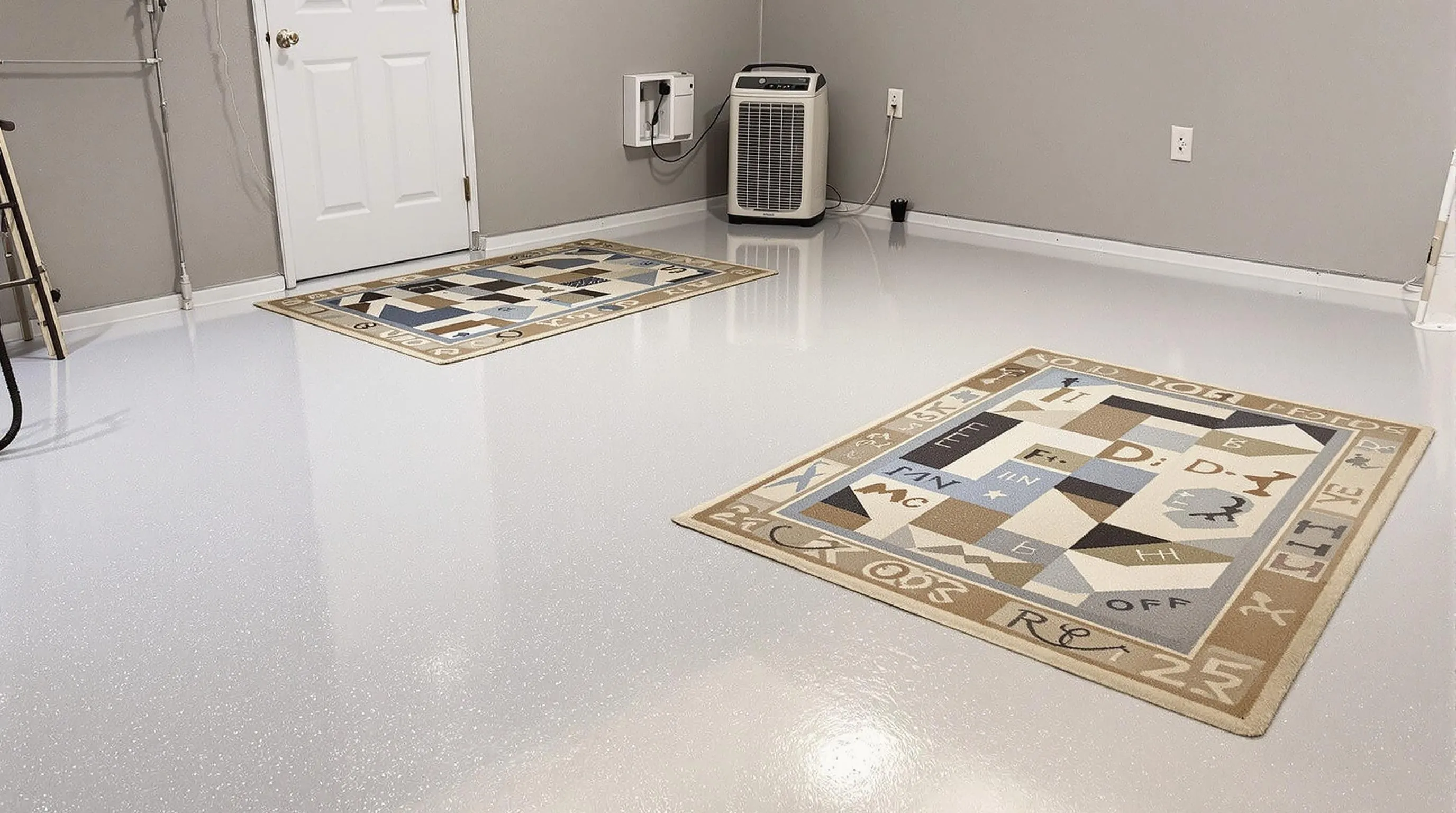
A well-maintained basement floor coating can last for years with proper care. Regular maintenance not only preserves the aesthetic appeal but also maximizes your investment in quality paint. Here’s how to keep your painted basement floor looking fresh and functional for the long term:
Regular Cleaning Routine
Gentle cleaning practices make a important difference in preserving your floor’s finish. Use mild detergents mixed with warm water for routine cleaning, applying with a soft mop or microfiber cloth. Harsh chemicals can break down the paint’s protective properties, so avoid bleach, ammonia, or abrasive cleaners that might damage the coating. For spills, address them immediately to prevent staining or seepage into the concrete beneath.
Preventing Wear and Damage
Strategic protection helps minimize daily wear on your painted basement surface. Place area rugs in high-traffic zones to reduce direct contact with the paint layer. Furniture legs should have protective pads to prevent scratches when items are moved. Heavy appliances require special consideration—use proper lifting techniques rather than dragging them across the floor when rearrangement is necessary.
Periodic Maintenance and Resealing
Applying a fresh sealer periodically creates an additional protective barrier against moisture. Inspect your floor every 1-2 years for signs of wear or thinning of the protective coating. Water beading on the surface indicates good sealing, while absorption suggests it’s time for reapplication. Follow manufacturer recommendations for compatible sealants that work with your exact floor paint type.
Addressing Minor Damage Promptly
Small chips or scratches should receive immediate attention before they expand into larger problems. Keep leftover paint for touch-ups on minor imperfections that develop over time. For deeper damage, clean the area thoroughly, apply a primer if necessary, and carefully match the existing paint. Feathering the edges of your repair helps blend it seamlessly with the surrounding floor.
Climate Control Considerations
Maintaining stable temperature and humidity levels protects your basement floor paint from premature deterioration. Use dehumidifiers during humid seasons to prevent moisture from affecting the paint bond with the concrete. Proper ventilation also plays a crucial role in preserving your floor coating by reducing condensation that can undermine adhesion over time.
By implementing these maintenance strategies, we’ve seen basement floor coatings last significantly longer than their expected lifespan. Remember that different paint types—especially epoxy versus latex-based products—may have exact care requirements, so always consult the manufacturer’s guidelines for optimal maintenance procedures.
Conclusion: Making the Best Choice for Your Basement Floor Paint
Choosing the right paint for your basement floor is a decision that balances durability moisture resistance and aesthetic appeal. We’ve seen how premium options like two-part epoxy systems and polyurea coatings offer outstanding performance while budget-friendly alternatives can work well for less demanding spaces.
Remember that proper preparation is crucial regardless of which product you select. The time and effort invested in cleaning etching and repairing your concrete surface will pay dividends in the longevity of your finished floor.
With regular maintenance and care your newly painted basement floor will enhance your home’s value provide greater comfort and create a more inviting living space for years to come. Trust your exact needs and budget to guide your final decision when selecting the perfect basement floor paint.
Frequently Asked Questions
What is the best type of paint for basement floors?
Epoxy coatings are generally considered the best option for basement floors due to their exceptional durability and moisture resistance. Two-part epoxy systems provide professional-quality results even for DIY applications. For high-moisture environments, polyurea/polyaspartic coatings offer advanced protection. Latex acrylic paints are more user-friendly but less durable. Your choice should primarily depend on your basement’s moisture levels, expected traffic, and your application comfort level.
How does painting basement floors increase home value?
Painting basement floors can increase your home’s value by up to 15% by transforming unfinished space into usable living area. Quality floor coatings create moisture barriers that prevent water damage and mold, reducing long-term maintenance costs. Painted floors also improve temperature regulation, reduce allergens, and create a more inviting atmosphere. Finished basements consistently rank among the top renovation projects for return on investment according to real estate experts.
Is special preparation required before painting a basement floor?
Yes, proper preparation is crucial. Start by thoroughly cleaning the floor to remove dirt, grease, and previous coatings. Repair any cracks or damaged areas with concrete filler. Most concrete floors require etching (with phosphoric acid solution or mechanical grinding) to create a profile for paint adhesion. Allow the floor to completely dry before painting – moisture tests are recommended. Follow specific preparation instructions for your chosen paint type for optimal results.
How long does basement floor paint typically last?
The lifespan varies significantly based on the paint type and maintenance. Premium epoxy coatings can last 10-20 years in residential settings with proper care. Polyurethane and polyurea systems typically last 7-15 years. Standard latex floor paints may need refreshing every 3-5 years in high-traffic areas. Factors affecting longevity include moisture levels, foot traffic, maintenance routines, and initial application quality. Regular cleaning and prompt repair of small damages significantly extend paint life.
What’s the difference between water-based and oil-based basement floor paints?
Water-based paints (acrylics/latex) offer easier application, faster drying, minimal odor, and simple cleanup with water. They’re more environmentally friendly with lower VOCs but generally less durable than oil-based alternatives. Oil-based paints provide superior durability, moisture resistance, and adhesion to difficult surfaces. However, they have stronger odors, longer drying times, require solvent cleanup, and typically contain higher VOCs, making ventilation crucial during application.
Can I paint over existing basement floor paint?
Yes, but proper preparation is essential. First, determine the existing paint type and ensure compatibility with your new coating. Clean thoroughly and lightly sand the surface to create adhesion. Remove any loose, flaking paint completely. Repair damaged areas and cracks. Some high-performance coatings like epoxy may require complete removal of previous paint layers. Always test compatibility in a small area first, and consider using a bonding primer for optimal adhesion.
Are there safety concerns with basement floor paint?
Some floor paints contain volatile organic compounds (VOCs) that can cause respiratory irritation, headaches, and other health issues. Choose low-VOC or zero-VOC formulations for better indoor air quality. Ensure proper ventilation during application and curing. Consider adding anti-slip additives to prevent falls, especially in areas that might get wet. Always follow manufacturer safety guidelines, wear appropriate protective equipment, and keep the area well-ventilated throughout the process.
How do I maintain painted basement floors?
Maintain painted basement floors with regular dry sweeping to remove abrasive debris. Clean spills immediately to prevent staining. Use mild detergents and soft mops for routine cleaning, avoiding harsh chemicals that can damage the coating. Place protective pads under furniture and avoid dragging heavy items. Control humidity levels to prevent moisture damage. Apply a refresher coat or sealer every few years as recommended by the manufacturer to extend the paint’s lifespan.
What is the cost difference between budget and premium basement floor paints?
Budget options like basic masonry paints cost $25-$40 per gallon and work adequately for low-traffic areas with minimal moisture issues. Premium epoxy systems range from $50-$150 per gallon but offer superior durability, moisture resistance, and longevity. While premium paints represent a higher initial investment, they typically provide better long-term value through extended lifespan (3-4 times longer than budget options) and reduced maintenance costs, making them more economical over time.
Can basement floor paint help with moisture problems?
While floor paint can provide a moisture barrier, it’s not a solution for serious water issues. Epoxy coatings and specialized sealers offer good resistance against minor dampness and humidity. However, significant water problems require addressing the underlying causes first (improving drainage, fixing leaks, installing sump pumps). For basements with moisture concerns, look for paints specifically labeled as “waterproof” or “moisture-resistant” and consider using a dedicated concrete sealer before painting.

